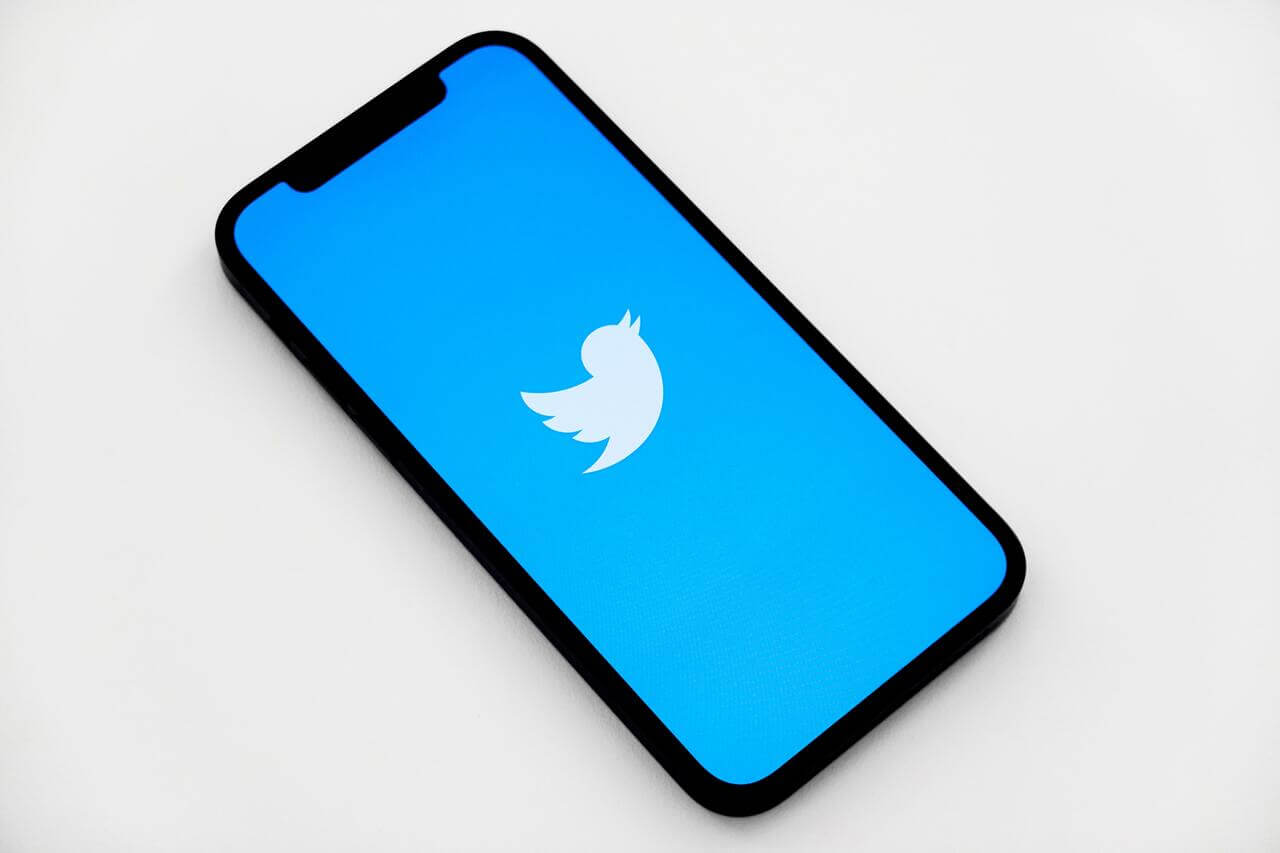So what does it take to create the world’s largest online marketplace? It seems impossible to fully comprehend how a small startup online bookseller became one of today’s most profitable companies.
The numbers don’t lie; according to Statista, Amazon’s annual revenue in 2020 was reported at 21.33 billion U.S. dollars, compared to 11.6 billion U.S. dollars in 2019. It keeps growing.
So how did the company grow its business? What decisions (good and bad) were they making? What challenges did they encounter, and how did they overcome them? There are many business lessons to be learned by examining Amazon’s history.
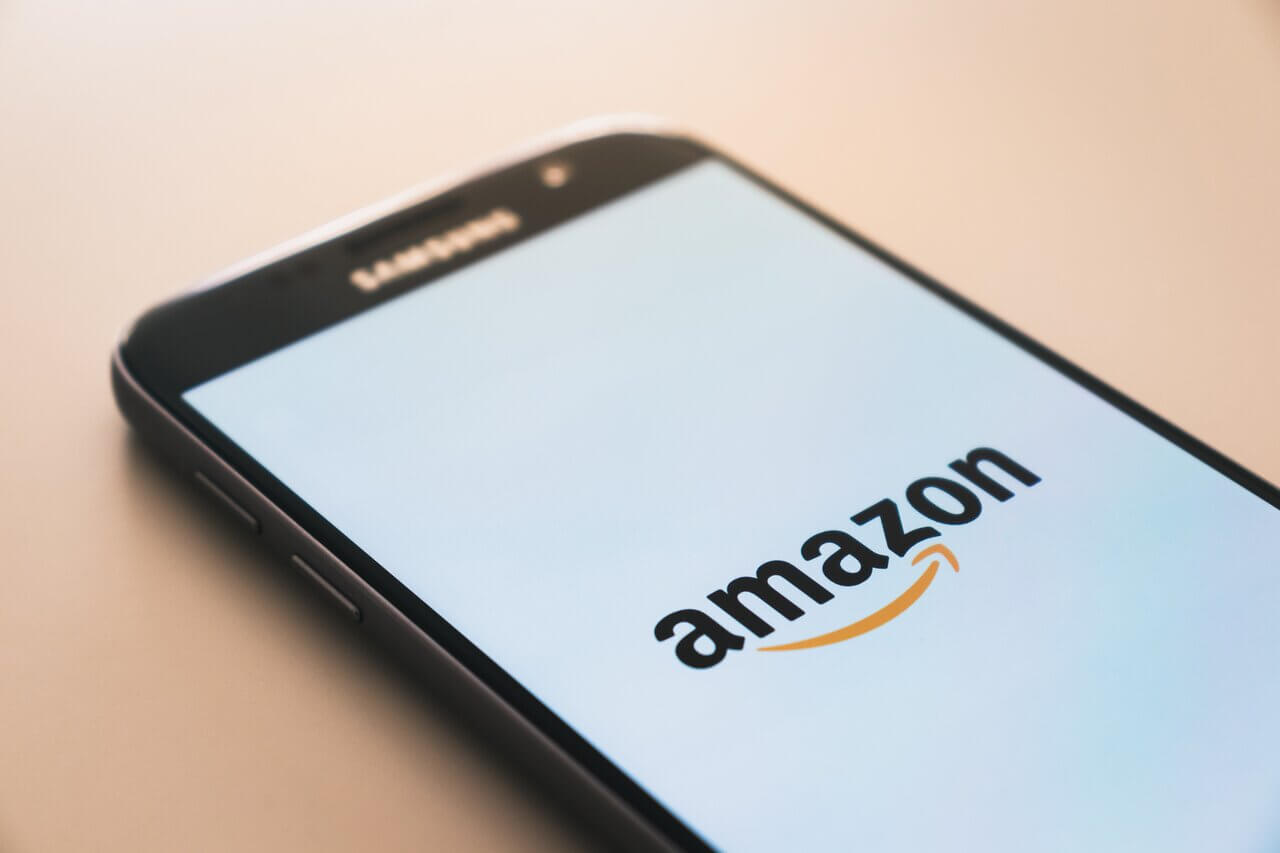
How and why it all began
Back in 1991, a Silicon Valley bookshop called Computer Literacy was the first to offer books online. When Amazon came into the picture, its business strategy was to provide convenience to the customer. It was different from what Computer Literacy was offering. Amazon thrived on delivering online orders to the customer directly at their chosen location anywhere in the world.
According to Jeff Bezos, the founder of Amazon, the motto was always “get big fast.” That’s exactly what Amazon did.
Back in the early to mid-90’s the internet was still very much in its infancy. In 1994, Bezos came across a statistic which predicted that internet users were likely to grow at 2300% annually.
It piqued his interest, and he jumped on the bandwagon, leaving his reasonably successful career as an investment banker. Of the top 20 things that made it to his list of things to sell, books appealed to him the most.
In a video from June 1997, Bezos explains why he chose books over everything else.
Books were great as the first best because books are incredibly unusual in one respect, that is that there are more items in the book category than there are items in any other category by far.
So the idea for Amazon (then called Cadabra.com) was to sell books online because:
- Customers would know precisely what they are buying.
- Amazon could easily cut off dealing with the thousands of publishers by negotiating with the two biggest book distributors in the 90s (Ingram and Baker & Taylor.)
- Of the sheer volume of inventory that Amazon could sell.
But that wasn’t all. Bezos had a plan to sell more than just books on the online marketplace. The vision was to expand and evolve into a tech company that offered online convenience to the customer.
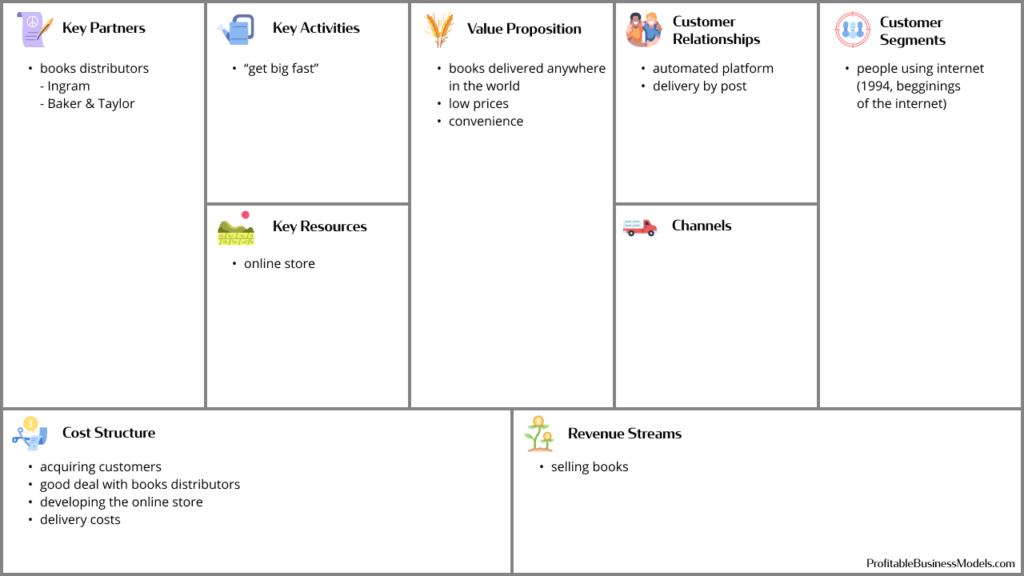
1994
After moving his family from New York to Seattle, Washington, Jeff Bezos opened Amazon.com in his rented home garage on the 5th of July 1994. He officially registered Amazon on the 1st of November 1994. A year later, after the formation of Amazon, the company would get its first order.
1995
On the 3rd of April 1995, Amazon received its first order. John Wainwright ordered a book called “Fluid concepts and creative analogies: Computer models of the fundamental mechanics of thought” by Douglas Hofstadter.
Early Competition
It was during these first years that Amazon experienced a lot of criticism from industry and financial experts. Journalists highly criticized the business model, comparing it to a ticking time bomb with the phrase “Amazon.bomb” often being coined. It seems impossible that promising to deliver goods to customers anywhere in the world or the U.S. would work out in the long run.
Bookstore giants like Barnes and Nobles were expected to drown the startup once they launched their own online book-selling marketplace.
As we all know, that didn’t happen. By the end of 1996, Amazon had 180,000 customers, and towards the end of 1997, Amazon was sitting at 1 million customers with active accounts. The company closed off that year with 148 million U.S. dollars in revenue.
This early success caused concern among the book industry giants. First, no one had matched up to Amazon’s online capacity. The combination of low prices, convenience, and selection was hard to compete against. As any company would, most bookstores felt the heat. Amazon was making ripples in the industry. To top it all off, they began diversifying from just selling books.
But it was not smooth sailing for the rising powerhouse. Apart from book industry giants, eBay and Alibaba were some of Amazon’s earliest competitors. Alibaba launched in December 1998 made it extremely difficult for Amazon to expand into China. And when Amazon tried to compete with eBay by building a rival auction site, it failed dismally. We will see more of some of Amazon’s failures and why they failed later on.
1997-2000: Amazon becomes public and presents long term strategy
Up until May 1997, Amazon had been a private company. However, it soon became apparent that for the company to expand, it needed more capital. In May 1997, Amazon was listed as a public company. The initial shares that were made available were three million, and each share was worth $18. By the end of the first day, Amazon stock was selling at $30. Bezos raised 54 million U.S. dollars on the NASDAQ exchange market.
In his first letter to shareholders at the end of 1997, Bezos coined the “Day 1” phrase, a core principle that Amazon still adheres to today. In that letter, Bezos presented the key elements that would make Amazon a success:
- Relentless focus on customers
- Creating long-term value over short-term corporate profit
- Bold innovation
“This is Day 1 for the Internet,” Bezos wrote, “and, if we execute well, for Amazon.com.”
The “Day 1” attitude is both culture and a way of operating the business that puts customers at the center of everything. The goal was and still is first to understand the customer and their pain or challenge. Then use that pain to develop innovative and convenient solutions for it. Amazon, always geared towards amplifying its value proposition in the eyes of the customer.
Despite this focus, Amazon was still not making a profit even with the tens of thousands of dollars in revenue it was making a week. It was a standard for startups. With investors becoming worried, Bezos explained that the goal was to defer profitability for at least five years to build infrastructure and technology.
This strategy is in line with the business model of modern-day Amazon. The concentration on infrastructure and technology was brilliant because Bezos understood that these would become part of the key resources that the company would need to thrive.
To this day, we see the same focus. Amazon pours millions of dollars towards developing data centers for its AWS services and the acquisition of robotics for its logistical operations.
Luckily, the lack of profit didn’t throw investors off, and in November 1997, Amazon opened its first fulfillment center in Delaware. It was in preparation for the expansion that was to come in 1998.
At the beginning of 1998, Amazon expanded its business and offered music and videos. The company also expanded to Germany and the United Kingdom by buying books sellers in the countries. It allowed Amazon to access customers outside of the U.S. at a low cost.
By the time 1999 rolled out, Amazon had fulfilled over 20 million orders in all fifty states and to over 150 countries around the world. Time Magazine honored Jeff Bezos as the “Person of The Year” in 1999. They also gave him the title “king of cyber-commerce,” and he was the youngest person to be recognized by Time magazine.
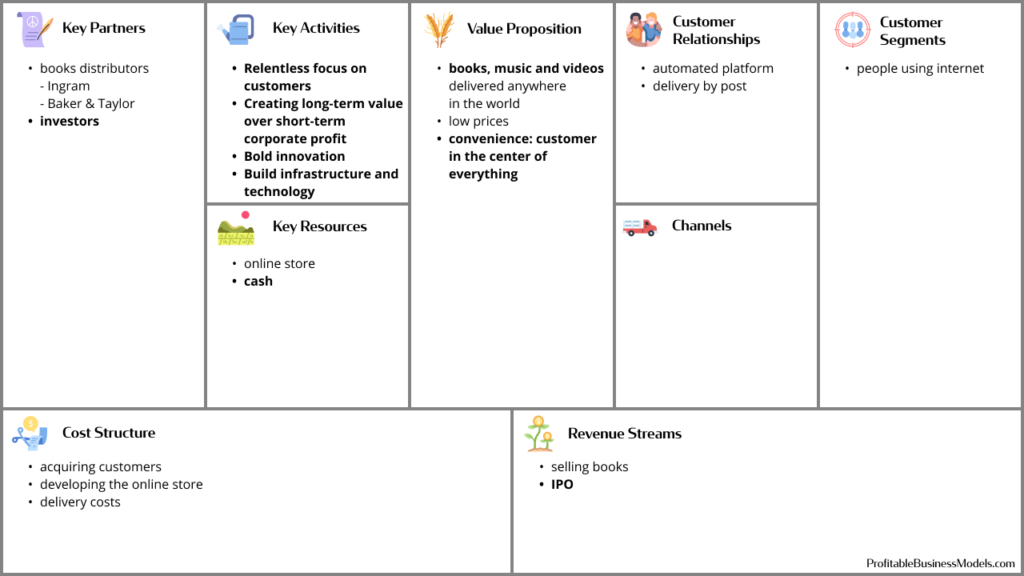
Amazon’s 1-Click patent
1999 also saw Amazon applying for and securing its first patent named 1-Click. It opened the door for split-second choices from the consumer, encouraging them to buy more items with ease. This technology was to be one of Amazon’s most significant advantages over its competitors.
“(…) the 1-Click patent (…) allowed Amazon to create a very strong position in the market (…) Most importantly, it allowed Amazon to show customers that there was a good reason to give them their data and the permission to charge them on an incremental basis.”
R. Polk Wagner, a professor at the University of Pennsylvania Law School
The 1-Click technology played right into one of Amazon’s key value propositions: convenience. It did away with the tiresome checkout process that most online shops still use today. In fact, Amazon made a lot of money licensing the technology to other big companies. For example, Apple bought the right to use it for its iTunes platform in 2000.
From 1997 to 2000, we see Amazon laying the foundations of the giant that we know today. Record-breaking sales, enormous revenue generation, mind-boggling, innovative expansions (such as Amazon’s highly profitable Affiliate Program launched in 1996), and extraordinary market dominance, it was unheard of. The transition from a bookstore to an ‘everything store’ had begun.
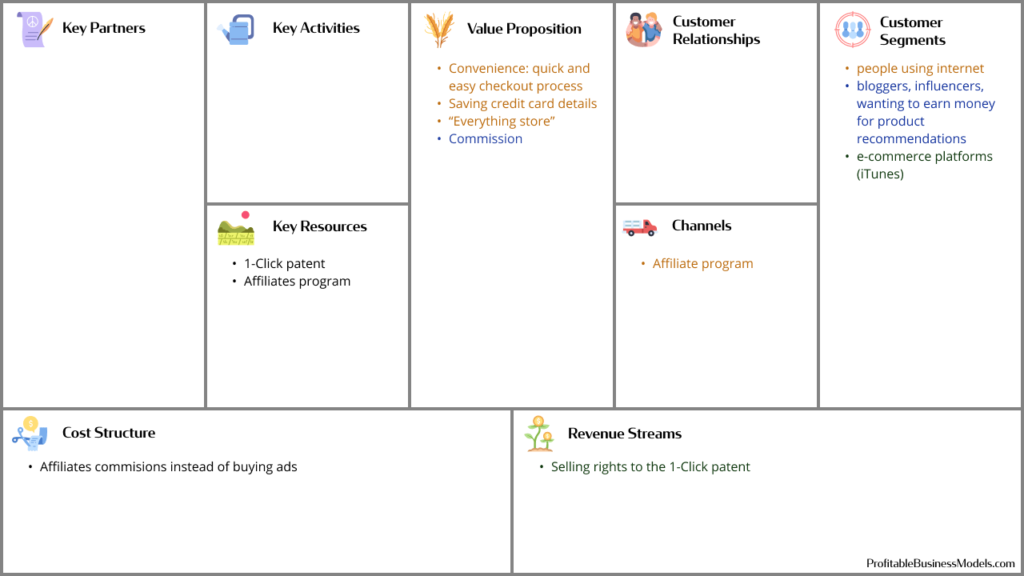
Despite all these strides, the company was yet to make a profit, and there were many missteps Amazon embarked on within these three years.
Early Failures
Between 1998 and 2000, Bezos went on a shopping spree, acquiring different companies in different industries at an alarming speed. His first venture was branching into toys, which differed utterly from books.
The challenge with toys was that there were no leading distributors. Amazon would have to buy the toys from the manufacturers and store them physically, hoping they would sell. It was the total opposite of Amazon’s business model, but Bezos was adamant, spending 120 million U.S. dollars to buy toys against the advice of his executives.
By the end of that adventure, over 50 million toys were left with no one to sell them to and nowhere to keep them. Amazon ended up having to sell the toys to exporters at ridiculously low prices and donating some of them to various charities. It was a big lesson for the company and Bezos.
As mentioned earlier, Amazon tried to compete with eBay by creating its own option, named Amazon Auctions. The company poured out 175 million U.S. dollars to acquire a company called Accept.com, which handled the transactions between buyers and sellers.
It was an epic fail because eBay had a significant market dominance that Amazon could not compete with. Amazon didn’t have enough buyers, it didn’t have enough sellers, and it did not have enough things to sell. But true to its M.O., the failed Amazon Auctions became one of the building blocks that led to the formation of Amazon Marketplace.
Also, in 1998, Amazon purchased a site called Junglee, meant to compete with Google and Yahoo search sites to cater for comparison shoppers. Amazon spent 170 million buying Junglee, but it was a very unpopular purchase within Amazon because executives felt it sent Amazon customers to third-party websites and encouraged competition. Within months, they abandoned the project.
Other notable purchases by Amazon within this period included imdb.com (a movie site), alexa.com (a data company), and the social networking company called planetall.com. The company also invested in several groceries, pets, and gear shops which all failed because Amazon lacked the capacity to handle all these diverse industries.
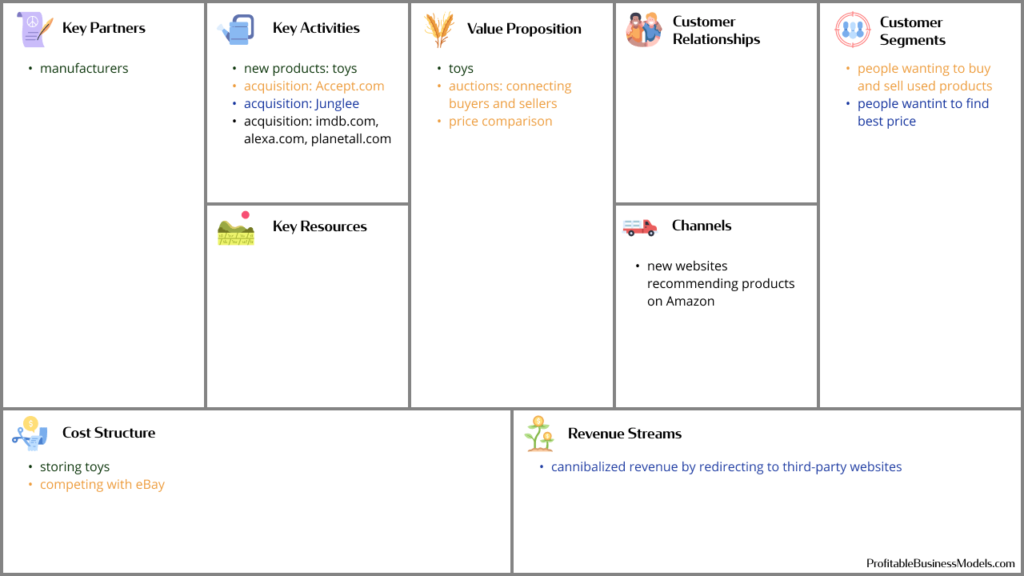
By the end of 2000, analysts and critics declared that Amazon was a failed company. An excerpt from an August 2000 newspaper clipping stated:
Unless shareholders get rid of Bezos and the buffoons in the boardroom, those clowns may add a new chapter to the books sold by AMZN called Chapter 11. This company is a joke, and so is its leadership.
It was a fitting analysis because right in the middle of 2000, the dot.com bubble burst happened.
Dot.com bubble burst
The dot.com bubble was a particularly glorious time for online-based companies. The growing interest in technology and startups by investors culminated in a rush to join the gravy train that lasted two years.
Throwing caution to the wind, most investors poured capital into companies that did not have business plans, did not have a track record of success, and did not know how to turn their ideas into profit.
In fact, some companies did not have a complete or working product before they went public. From 1998 to 2000, many startups in the Tech industry gained enormous value overnight. Unfortunately, it all came crashing down when panic selling of stocks began.
Most of the dot.com bubble companies became worthless in a matter of months. Surprisingly, Amazon and a few other online companies like eBay survived the dot.com bubble burst.
It is a notable event in the history of Amazon because it did away with most competitors in the industry. But it also showed that Amazon was doing something right. While most of the startups were crashing, for Amazon, it was business as usual. Seen as the “poster boy for ‘Internet 1.0’ excess of promises over reality.” Amazon proved its critics wrong.
When the crash happened, Amazon had yet to make a profit on its annual statement. It put it in grave danger because investors were also worried about the company failing.
Amazon survived because it had an actual working business model. Its value proposition was solid because it addressed a genuine need in the market. Amazon’s customers were very willing to spend on the convenience that the company brought into their lives.
Although the company survived the initial burst, it eventually felt the ripple effects of the dot.com bubble crash a year later. Amazon had to lay off over 1,000 employees and closed off some of its centers in Seattle. The company also had to downsize some of its operations in order to ride the wave.
2002 – 2010: The road to success
A lot of significant things happened from 2002 onwards. It seems they had thoroughly scratched the acquisition itch, and now the focus shifted to expanding Amazon but sticking to its original business model.
It proved to be a successful strategy because the 2000s were an excellent decade for Amazon. Many of its biggest successes today were founded in the early and mid-2000s. In 2002 Amazon ventured into selling clothes online by partnering with 400 clothing brands to cater to a wide range of customers.
Amazon was finally in its element, and the brutal lessons learned from the 90s seemed to pay off. At the end of 2003, Amazon finally made a profit of 35.5 million U.S. dollars. It was a first for the company who had recorded a loss the previous year.
In 2004, Amazon also managed to venture into the Chinese market by investing $75 million into Joyo.com. Amazon could finally start selling books, music, and videos through this Chinese retail company.
Amazon Prime
As if things couldn’t get any better, Amazon launched its Prime subscription services in February 2005. Initially aimed at faster delivery only, Prime has morphed into one of the company’s highest revenue streams. With millions of subscribers, Amazon Prime now offers access to shorter delivery times, free unlimited storage, access to millions of songs on Amazon Music, video streaming services, and so much more.
Amazon Kindle
Going back to its online bookstore roots, the company launched its first product, the Kindle, in November 2007. This e-book platform and the device allow users to download and browse through an enormous selection of literature.
Over the years, Amazon has continuously worked toward improving and tweaking its Amazon Kindle product. From producing newer Kindle devices to launching the Amazon Kindle Program, the rate at which the company adapts is astonishing.
AWS
Jeff Bezos’ vision for Amazon finally came to light with the launch of the Amazon AWS service. But that was not the initial plan.
They launched AWS as a way to bring in third-party merchants onto the Amazon e-commerce platform. Amazon developers were having a hard time figuring out how to integrate Amazon’s e-commerce engine with that of third-party merchants like Target.
Since its launch, AWS has become one of the world’s most successful cloud infrastructure service companies. As of 2016, AWS had more than a 30% share of the market, more than Microsoft, IBM and Google combined.
In December 2007, Amazon announced it would consolidate its workforce by bringing them into one building. They launched the new headquarters for the company in Seattle.
Again in 2008, Amazon decided that it wanted to dominate and capitalize on the popularity of audiobooks. It bought Audible for $300 million, outbidding Apple. The last year of the decade saw even more expansion from Amazon when it bought Zappos in 2009. It allowed the company to have a foothold in the online shoe retail industry, where it had been struggling to beat Zappos.
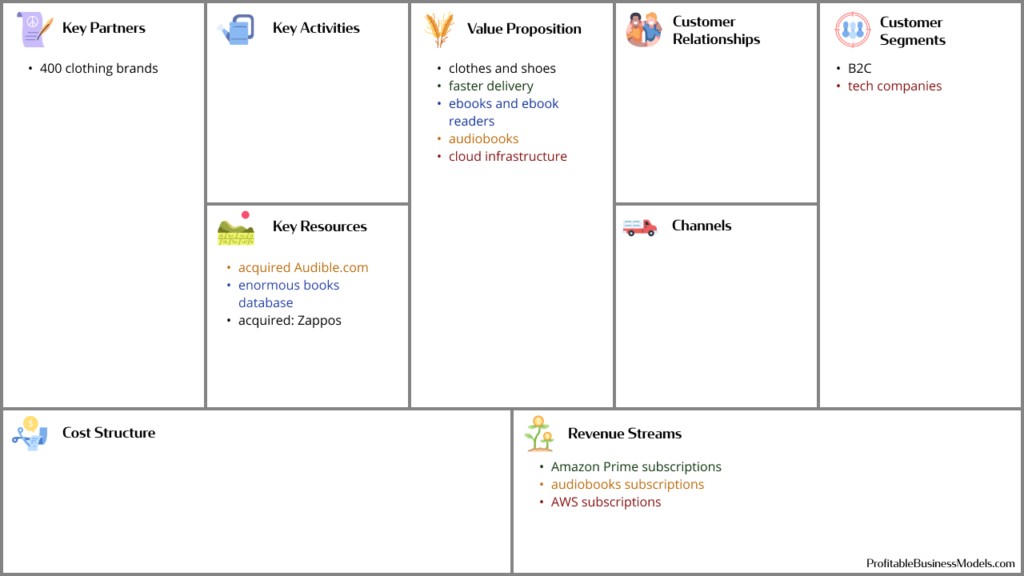
2010-2020: Boosting logistics
During this decade, an essential purchase for Amazon came in 2012 when it bought Kiva, a robotic company. The robots can move packages that weigh as much as 700 lbs. It was a great move in terms of enhancing the logistics and operational side of the business. The fulfillment centers were now fully equipped and more efficient in managing operations. It certainly furthered the competitive advantage that Amazon had.
This decade would see Amazon take steps into gaming (Twitch Interactive, 2014), grocery business (Whole Foods, 2017), and so much more. They also struck a deal with USPS in 2013 to begin delivering orders on Sunday, meaning customers could now get their products 24/7.
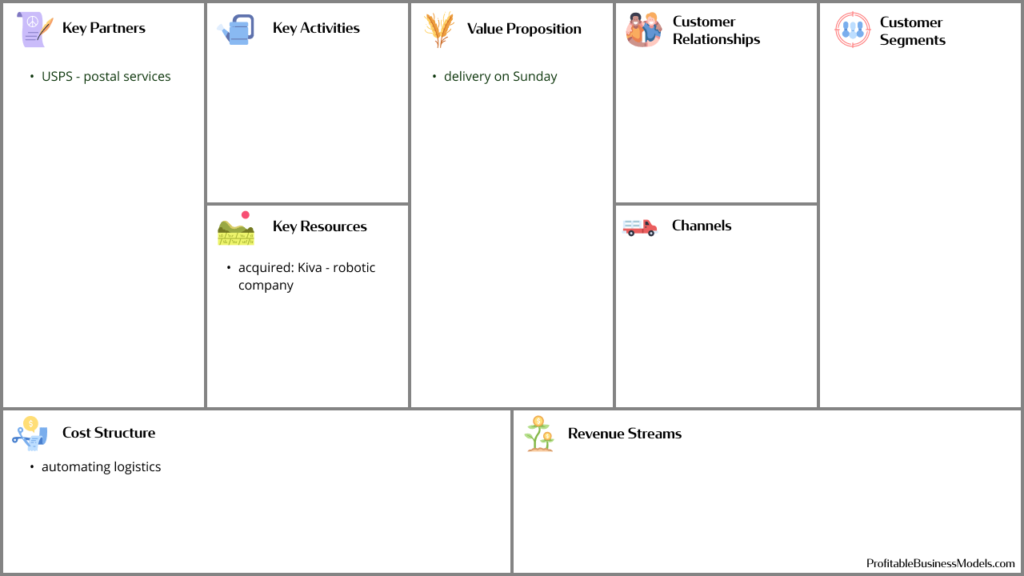
Some grand failures plagued Amazon during this area. The most significant being the Fire Phone released in 2014. It wasn’t well-received because there were better mobile phones on the market. It was overpriced and without a lot of the functions and apps that standard phones had. Amazon lost over $200 million on this miss-adventure.
How Amazon achieved worldwide dominance
Throughout the year’s Amazon has focused on building infrastructure, expanding channels, and partnering with key companies. They wanted to:
- ensure that they had enough resources to keep prices low or competitive,
- widen their selection of goods and services,
- enhance their delivery, and
- keep improving on their customers’ convenience.
These four elements are the backbone of Amazon’s value proposition. Everything the company embarked on was (and still is) focused on strengthening these core elements of the business.
The appeal of convenience is still the number one reason why Amazon is successful today. Customers can search and find anything they want in the comfort of their own homes.
It is not about the goods that Amazon sells; it is the customer loyalty they have earned by continuously finding ways to deliver fast and giving the customer what they need and want whenever they want it.
Customer loyalty is strongly tied to the product review tools that the Amazon site offers. When you throw in customer trust and foster good customer relationships, success seems almost inevitable.
The bottom line is this: Amazon’s success results from innovation, a bit of luck, and finding the balance between sticking to what you know works versus taking calculated risks that may or may not pay off.
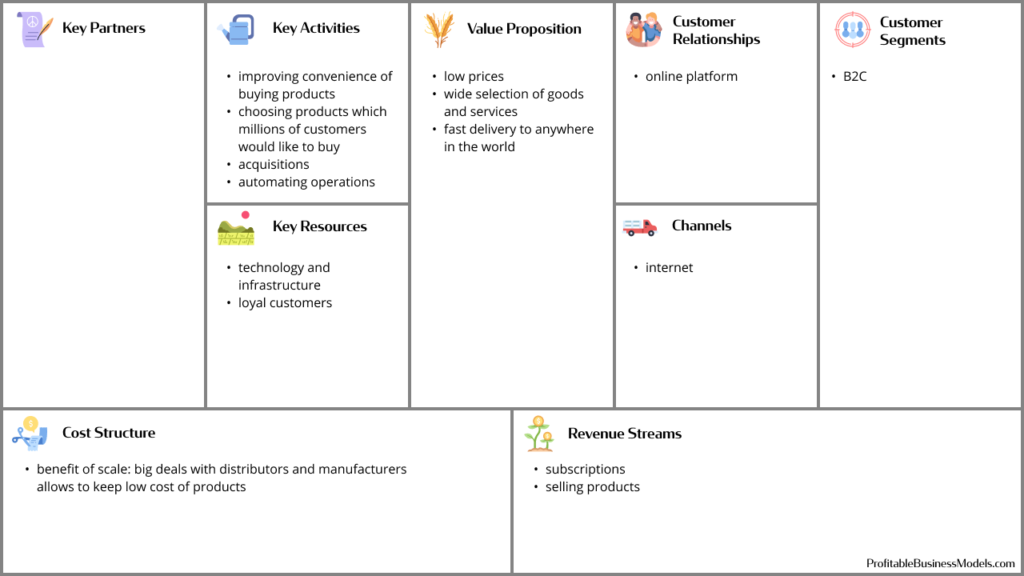
Conclusion
So what can businesses learn from the successes and failures of Amazon? A lot! But the most crucial lesson we think we can glean from Amazon is to treat each day as if it’s “Day 1”. We can interpret the famous Bezos phrase in many ways. But if we examine what has kept Amazon afloat and thriving all these years, it will most certainly be the “Day 1” attitude.




